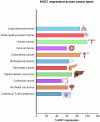Mucin-1: a promising pan-cancer therapeutic target
- PMID: 40604087
- PMCID: PMC12223159
- DOI: 10.1038/s41698-025-01016-2
Mucin-1: a promising pan-cancer therapeutic target
Abstract
Mucin1 or MUC1 (also known as CD227, EMA, MCD, MAM6, PEM, PUM, KL-6, CA 27.29/CA 15-3) is a highly glycosylated transmembrane mucin family member protein that is overexpressed in various solid or hematological cancers. Abnormal MUC1 expression/glycosylation in cancer leads to the activation of multiple pathways, resulting in tumor migration, invasion and accelerated growth. CA 27.29/CA 15-3 are blood tumor markers used in breast cancer patients. Novel therapeutic agents targeting MUC1, including cancer vaccines, cellular therapies, radiopharmaceuticals, monoclonal antibodies and antibody-drug conjugates, are being explored in clinical studies. The current review summarizes the molecular mechanisms of MUC1 in cancer and highlights existing data for MUC1-targeting agents in the therapeutic pipeline.
© 2025. The Author(s).
Conflict of interest statement
Competing interests: Dr. Kurzrock has received research funding from Boehringer Ingelheim, Debiopharm, Foundation Medicine, Genentech, Grifols, Guardant, Incyte, Konica Minolta, Medimmune, Merck Serono, Omniseq, Pfizer, Sequenom, Takeda, and TopAlliance and from the NCI; as well as consultant and/or speaker fees and/or advisory board/consultant for Actuate Therapeutics, AstraZeneca, Bicara Therapeutics, Inc., Biological Dynamics, Caris, Datar Cancer Genetics, Daiichi, EISAI, EOM Pharmaceuticals, Iylon, LabCorp, Lanuaria, Merck, NeoGenomics, Neomed, Pfizer, Precirix, Prosperdtx, Regeneron, Roche, TD2/Volastra, Turning Point Therapeutics, X-Biotech; has an equity interest in CureMatch Inc.; serves on the Board of CureMatch and CureMetrix, and is a co-founder of CureMatch.
Figures



Similar articles
-
A rapid and systematic review of the clinical effectiveness and cost-effectiveness of paclitaxel, docetaxel, gemcitabine and vinorelbine in non-small-cell lung cancer.Health Technol Assess. 2001;5(32):1-195. doi: 10.3310/hta5320. Health Technol Assess. 2001. PMID: 12065068
-
Interventions for promoting habitual exercise in people living with and beyond cancer.Cochrane Database Syst Rev. 2018 Sep 19;9(9):CD010192. doi: 10.1002/14651858.CD010192.pub3. Cochrane Database Syst Rev. 2018. PMID: 30229557 Free PMC article.
-
MUC1 as a diagnostic biomarker and siRNA-based therapeutic target in breast cancer: A clinical chemistry perspective.Clin Chim Acta. 2025 Aug 15;576:120387. doi: 10.1016/j.cca.2025.120387. Epub 2025 May 25. Clin Chim Acta. 2025. PMID: 40425136 Review.
-
A systematic review of the effectiveness of adalimumab, etanercept and infliximab for the treatment of rheumatoid arthritis in adults and an economic evaluation of their cost-effectiveness.Health Technol Assess. 2006 Nov;10(42):iii-iv, xi-xiii, 1-229. doi: 10.3310/hta10420. Health Technol Assess. 2006. PMID: 17049139
-
Systemic pharmacological treatments for chronic plaque psoriasis: a network meta-analysis.Cochrane Database Syst Rev. 2017 Dec 22;12(12):CD011535. doi: 10.1002/14651858.CD011535.pub2. Cochrane Database Syst Rev. 2017. Update in: Cochrane Database Syst Rev. 2020 Jan 9;1:CD011535. doi: 10.1002/14651858.CD011535.pub3. PMID: 29271481 Free PMC article. Updated.
References
-
- Subbiah, V., Gouda, M. A., Ryll, B., Burris, H. A. 3rd & Kurzrock, R. The evolving landscape of tissue-agnostic therapies in precision oncology. CA Cancer J. Clin.74, 433–452 (2024). - PubMed
-
- Fountzilas, E., Tsimberidou, A. M., Hiep Vo, H. & Kurzrock, R. Tumor-agnostic baskets to N-of-1 platform trials and real-world data: transforming precision oncology clinical trial design. Cancer Treat. Rev.125, 102703 (2024). - PubMed
-
- Adashek, J. J., Subbiah, V. & Kurzrock, R. From tissue-agnostic to N-of-one therapies: (R)evolution of the precision paradigm. Trends Cancer7, 15–28 (2021). - PubMed
Publication types
LinkOut - more resources
Full Text Sources
Research Materials
Miscellaneous

